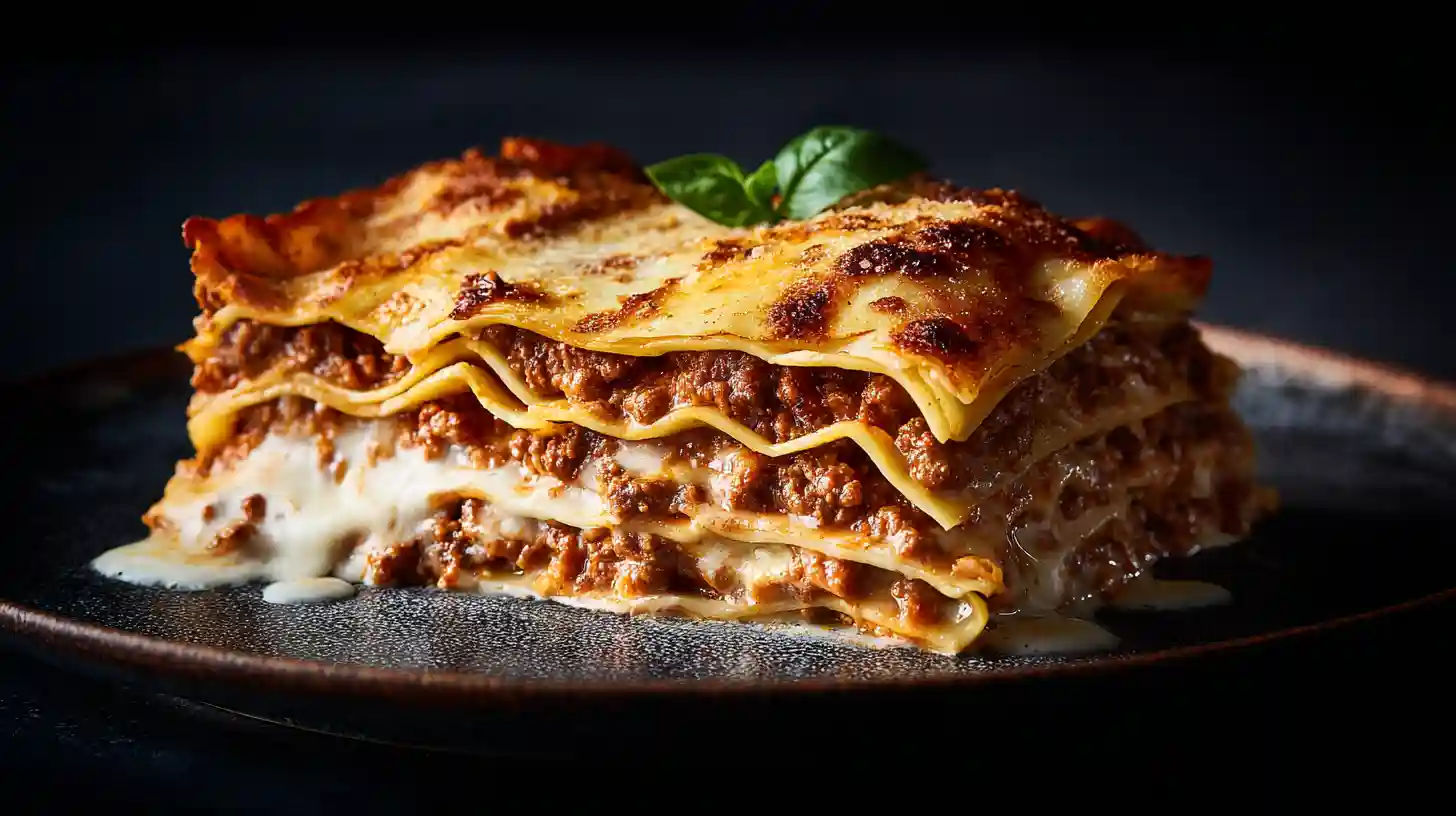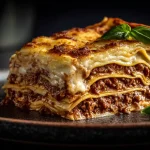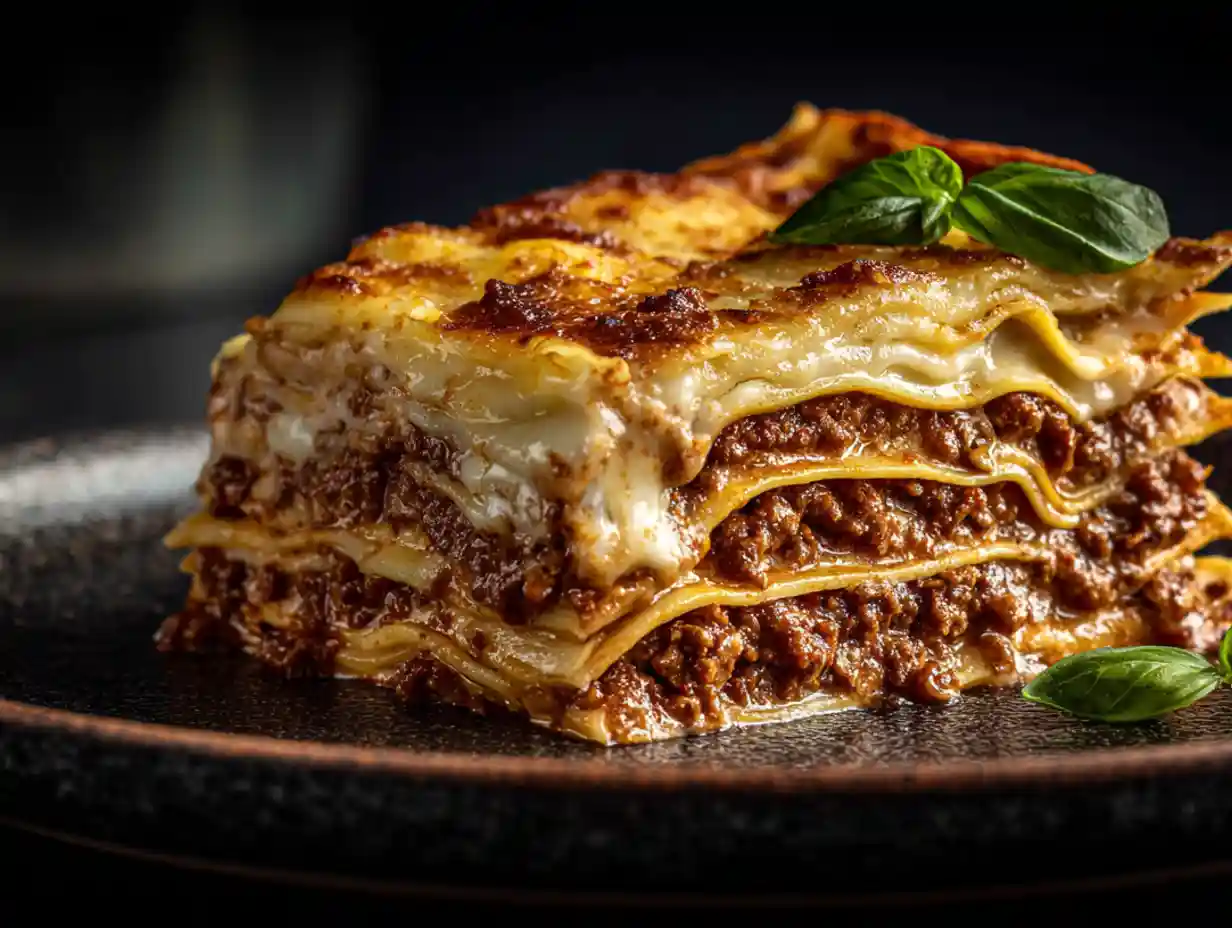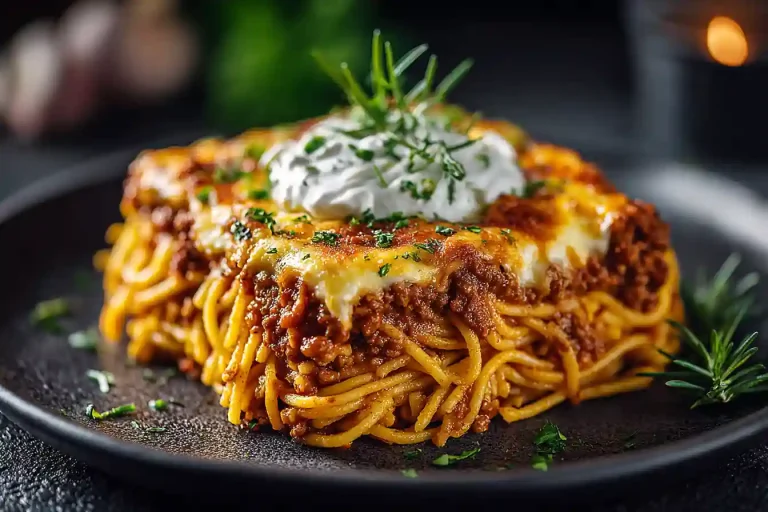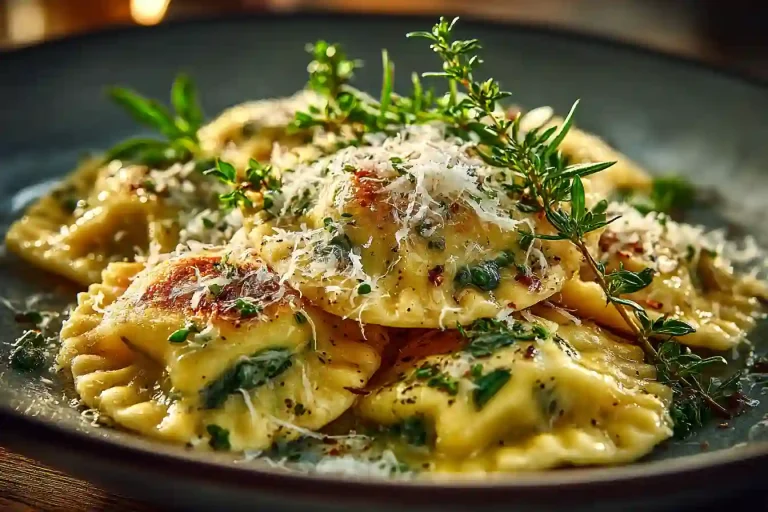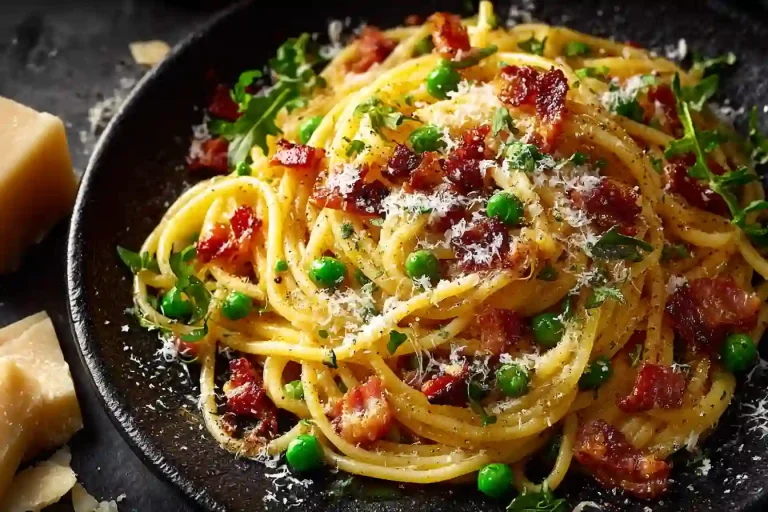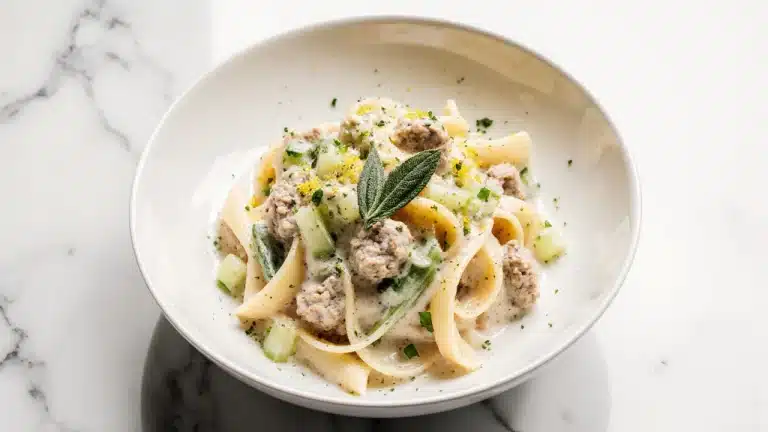Gordon Ramsay Lasagna (The Ultimate 3-Hour Method for Perfection)
A real Gordon Ramsay lasagna is a statement. It’s a weekend project, a commitment to building deep, complex flavor from the ground up. But search for a recipe online, and you’ll find a minefield of shortcuts and bad advice—recipes that result in the one thing we all fear: a watery, soupy lasagna that floods the plate. I know, because I’ve been there. My first attempt was a delicious soup, but it certainly wasn’t a lasagna. I got tired of the failure.
I’m Jack Barrett. I don’t do shortcuts. I went back to the original TV masterclasses and documented the authentic method. The secrets to a rich, slow-simmered ragù, a perfectly smooth béchamel, and the non-negotiable steps for assembling a structurally sound masterpiece. This is not another “easy” recipe. This is the blueprint for the authentic Gordon Ramsay lasagna.
The Method: The Two Sauces That Define a Masterpiece
A showstopper Gordon Ramsay lasagna is built on the foundation of two perfect sauces. If one of them is flawed, the entire dish is compromised. Understanding the science behind them is the first step toward mastery. This is what separates a true Gordon Ramsay lasagna from all the pretenders.
- The Ragù Bolognese (The Flavor Engine): A thirty-minute meat sauce will never work for a Gordon Ramsay lasagna. Never. The deep, rich flavor comes from a slow, patient simmer. The process begins with a classic soffritto—finely chopped onion, carrot, and celery—sweated down to create a sweet, aromatic base. The meat is browned properly, the pan is deglazed with red wine, and then a classic Bolognese secret is added: milk. The milk helps tenderize the meat during the long cook. The sauce is then simmered for a minimum of two hours, allowing the flavors to meld and the sauce to become thick and rich. The final ragù for your Gordon Ramsay lasagna should be thick enough for a wooden spoon to stand in it.
- The Béchamel (The Creamy Structure): This is where most home cooks fail, ending up with a lumpy, floury paste. The secret to the flawless, creamy béchamel in a Gordon Ramsay lasagna is twofold. First, you must cook the roux (the butter and flour mixture) for a full minute to eliminate the raw flour taste. Second, and this is the most critical step, you must use hot milk, added gradually while whisking constantly. Adding cold milk to a hot roux causes the mixture to seize and form lumps. Hot milk allows the sauce to emulsify beautifully into a smooth, velvety sauce, perfect for layering your Gordon Ramsay lasagna.
Mistake Watchouts: I Made Lasagna Soup So You Don’t Have To
The number one fear of any lasagna maker is cutting that first slice and watching it collapse into a watery puddle. My first attempt at a Gordon Ramsay lasagna was exactly that. It tasted great, but its soupy texture was a complete failure. A true Gordon Ramsay lasagna should stand tall. Here’s what I learned.
- The Mistake: A Watery, Soupy Mess. This is the cardinal sin of lasagna making. A soupy lasagna is the direct result of three failures: a thin meat sauce, improper layering, or impatience.
- The Fix #1 (A Thick Ragù): Your meat sauce must be thick. If it’s watery going into the dish, it will be watery coming out. Simmer it longer than you think you need to.
- The Fix #2 (Proper Layering): The foundation of a Gordon Ramsay lasagna is a thin layer of ragù and béchamel on the bottom of the dish—this prevents the first pasta layer from sticking. From there, it’s a disciplined process of pasta, ragù, béchamel, and Parmesan, repeated.
- The Fix #3 (The Critical Rest): This is non-negotiable. After you pull the beautiful, bubbly Gordon Ramsay lasagna from the oven, you must let it rest for at least 20 minutes, and ideally 30. This allows the sauces and pasta to set. Slicing it immediately is a guarantee of soup.
- The Mistake: A Lump-Filled Béchamel. My first béchamel was a disaster. I dumped cold milk into my roux and it instantly became a lumpy paste that I couldn’t save. A perfect Gordon Ramsay lasagna demands a perfect béchamel.
- The Fix: Use hot milk. Heat your milk in a separate saucepan until it’s steaming. Add it to the roux one ladle at a time, whisking constantly. The result will be a perfectly smooth, creamy sauce.
The Recipe: Gordon Ramsay’s Perfect Lasagna Bolognese
Gordon Ramsay’s Perfect Lasagne Bolognese
Ingredients
Equipment
Method
- Make the Ragù: Heat olive oil in a large Dutch oven. Add onion, carrot, and celery (the soffritto) and cook until soft, 10-15 minutes. Add garlic. Increase heat, add ground meats, season with salt and pepper, and brown completely. Drain excess fat. Deglaze with red wine, scraping the pan bottom, and cook until evaporated. Add milk and cook until evaporated. Stir in crushed tomatoes and bay leaf. Bring to a simmer, then reduce heat to low, cover, and cook for at least 2 hours. The sauce should be very thick.
- Make the Béchamel: In a medium saucepan, melt butter over medium heat. Whisk in the flour and cook the roux for 1 minute. Meanwhile, heat the milk in a separate pan until hot (not boiling). Gradually add the hot milk to the roux, one ladle at a time, whisking constantly until smooth. Bring to a simmer, cook for 5-10 minutes until thickened. Remove from heat, stir in Parmesan and nutmeg. Season to taste.
- Prep for Assembly: Preheat oven to 375°F / 190°C. Cook lasagna noodles in a large pot of salted boiling water until al dente. Drain and lay flat on oiled baking sheets to prevent sticking.
- Assemble the Lasagna: Spread a thin layer of ragù on the bottom of a 9×13 inch baking dish. Follow with a thin layer of béchamel. Lay down a single layer of pasta sheets. Top with a layer of ragù, then a layer of béchamel, then a sprinkle of Parmesan. Repeat the layers until you run out of ingredients, finishing with a final layer of pasta topped with a generous layer of béchamel, the torn mozzarella, and a final sprinkle of Parmesan.
- Bake and Rest: Cover with foil and bake for 25 minutes. Remove the foil and bake for another 15-20 minutes, until the top is golden and bubbly. **CRITICAL STEP:** Let the lasagna rest on a wire rack for at least 20-30 minutes before slicing.
Nutrition
Notes
Love this recipe?
Give us 5 stars and comment!The Execution: Step-by-Step
(For the Ragù)
- Sauté finely chopped onion, carrot, and celery in olive oil until soft. Add minced garlic and cook for another minute.
- Add ground beef and pork, breaking it up and browning it completely. Drain any excess fat.
- Deglaze the pan with red wine, scraping up any browned bits. Let it reduce completely.
- Stir in milk and let it evaporate. Add crushed tomatoes, tomato paste, and herbs (like bay leaf and oregano).
- Bring to a boil, then reduce to a very low simmer. Cover and cook for at least 2 hours, stirring occasionally, until thick and rich. Remove the bay leaf and season to taste.
(For the Béchamel)
- In a saucepan, melt butter over medium heat. Whisk in flour and cook for 1 minute.
- Meanwhile, heat the milk in a separate pan until steaming.
- Gradually add the hot milk to the roux, one ladle at a time, whisking constantly until each addition is incorporated and the sauce is smooth.
- Bring the sauce to a simmer and cook for 5-10 minutes until thickened. Remove from heat, stir in grated nutmeg and Parmesan cheese. Season with salt and pepper.
(Assembly & Baking)
- Preheat oven to 375°F (190°C).
- Cook lasagna sheets in salted boiling water until al dente.
- Spread a thin layer of ragù and béchamel on the bottom of a baking dish.
- Begin layering: a single layer of pasta, a layer of ragù, a layer of béchamel, and a sprinkle of Parmesan. Repeat until all ingredients are used, finishing with a final layer of béchamel and a generous topping of Parmesan.
- Bake for 30-40 minutes, until the top is golden brown and bubbly.
- Rest the lasagna for at least 20-30 minutes before slicing and serving. This is the most critical step for a clean slice.
Sanctioned Riffs (Variations That Respect the Method)
The method for building a Gordon Ramsay lasagna is precise, but you can make minor ingredient swaps. Using a mix of beef, pork, and veal in the ragù will add another layer of complexity. Adding a splash of Worcestershire sauce or a few anchovy fillets to the ragù will boost its umami flavor. The core techniques—the slow-simmered ragù and the hot-milk béchamel—must remain.
Plating and Execution
After its crucial rest, a Gordon Ramsay lasagna should be easy to serve. Use a sharp spatula or knife to cut a clean, square slice. The beauty of this dish is seeing the distinct layers stand tall on the plate. A simple garnish of a fresh basil leaf is all that’s needed. The dish itself is the showstopper. This is the visual proof that you’ve created a perfect Gordon Ramsay lasagna.

Recipe FAQs
Can I use no-boil noodles for a Gordon Ramsay lasagna?
You can, but the texture will be slightly different. For the most authentic result, Ramsay uses fresh or high-quality dried pasta sheets that are boiled until al dente before layering. This gives you more control over the final texture of your Gordon Ramsay lasagna.
Why did my Gordon Ramsay lasagna come out dry?
A dry lasagna is usually the result of a meat sauce that was too thick or not enough béchamel sauce used between the layers. Both sauces provide the necessary moisture for the pasta to finish cooking in the oven without drying out.
Can I assemble the Gordon Ramsay lasagna ahead of time?
Yes. You can assemble the entire Gordon Ramsay lasagna a day in advance. Cover it tightly with plastic wrap and refrigerate. You will need to add 15-20 minutes to the baking time since you are starting from cold.
The Result & Conclusion
When you slice into it, you see success. The slice stands tall, showcasing perfect, distinct layers of rich ragù, creamy béchamel, and tender pasta. The top is a beautiful, golden-brown crust of bubbly cheese. The flavor is incredibly deep and complex—a result of the patient, slow simmer. This is not just any lasagna; it’s a testament to the power of proper technique. You have successfully created the authentic Gordon Ramsay lasagna.
Your Turn. Get to Work.
You’ve mastered a true Italian-American icon. Now, apply that same patience and precision to other classics. Continue your education with the definitive guide to Gordon Ramsay’s Pasta an Rice Recipes.

